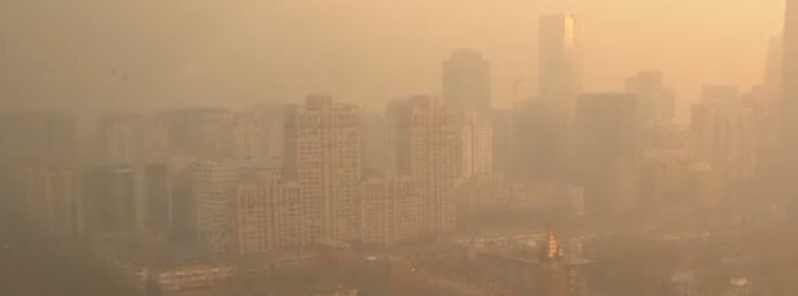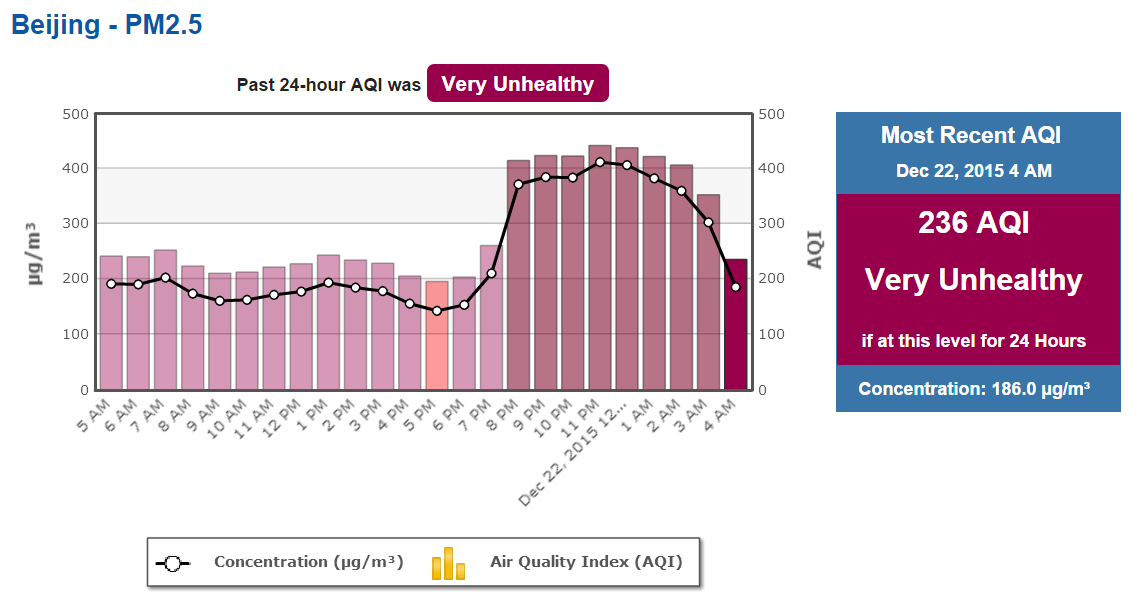Beijing issues a red alert for hazardous smog pollution for the second time ever

Residents of China are experiencing another wave of severe smog pollution since December 18, 2015. The smog conditions have prompted Beijing authorities to issued its second red alert in the history, as hazardous conditions have been expected to last more than three days.
The local authorities continue to battle the thick smog that covered over 20 cities across northern China, including the capital Beijing, Hebei, Henan, Shandong, Shanxi, and Tianjin, over the last couple of days.

Image credit: US Mission China
The smog particles PM2.5 only 2.5 microns in diameter pose a dangerous health threat to the residents. According to the local authorities, the pollution level will peak on December 22 before a strong cold front starts to influence the regions and clears the air.
The US embassy's air quality monitor in Beijing reported a "very unhealthy" concentration level of 186 micrograms of particles per cubic meter, accompanied with an Air Quality Index (AQI) of 236 on December 22 (local time). A concentration level of 86 micrograms per cubic meter and AQI of 168 was observed in Shangai at the same time.
"Air pollution worsens during the second-ever red alert for Beijing" https://t.co/Zqa4FSm0tu pic.twitter.com/g62rRMJbm4
— Arthur Charpentier (@freakonometrics) December 21, 2015
Maximum limit of PM2.5 particles is 25 micrograms per cubic meter in a 24 hour period, according to the World Health Organization.
The average density of PM2.5 class aerosols in 74 cities dropped 16% so far this year, according to Environment vice-minister Li Ganije.

Video credit: Kazakh TV
As the red alert was issued, Beijing ordered a car ban, although some experts think this action is only capable of producing a limited effect. However, measures such as putting the work of the polluting factories to a halt will probably have a much stronger effect.
The best strategy will be to upgrade the industrial structure to capabilities of using clean energy, which will be a long and difficult process and could last between 30 and 50 years, according to Zhang Dawer, head of the Beijing Environmental Emergency Center.
Beijing issues 2nd air quality "red alert," just days after Paris climate agreement. Heavy pollution to last 4 days. https://t.co/wHrAYcFgXH
— InsideClimate News (@insideclimate) December 18, 2015
The Chinese government plans to reduce pollution levels by restricting emissions from coal-fired power plants by 50% over the next five years.
"The industrial development of this region has far exceeded the capacity of the environment. We must strictly enforce the Environmental Law, closing down the polluters that fail to meet the standards," But Ma Jun, director of the Beijing Institute of Public and Environmental Affairs stated.
Featured image: Thick smog in Beijing, December 20, 2015. Image credit: Kazakh TV

Commenting rules and guidelines
We value the thoughts and opinions of our readers and welcome healthy discussions on our website. In order to maintain a respectful and positive community, we ask that all commenters follow these rules:
We reserve the right to remove any comments that violate these rules. By commenting on our website, you agree to abide by these guidelines. Thank you for helping to create a positive and welcoming environment for all.